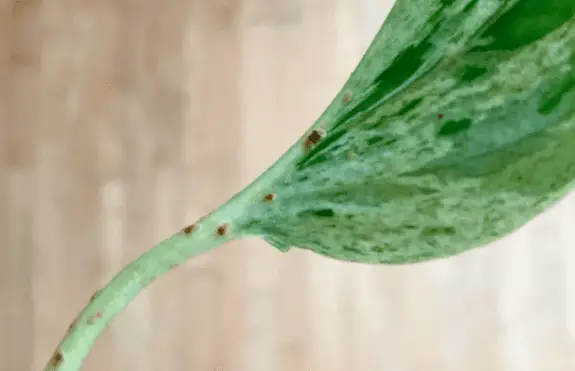Do you have a pothos plant at home? If so, you may have noticed small bumps on the stem. Don’t worry, you’re not alone! This is a common problem with pothos plants and there is no need to panic.
In this blog post, we will discuss what causes these bumps and how to treat them. We will also provide some tips for preventing them from occurring in the first place.
What Are the Bumps on Pothos Stem?
The bumps you are seeing on your pothos stem are most likely aerial roots or scale. While aerial roots are not harmful to your plant, the scale can be. Scale is a type of insect that feeds on plant sap. They are usually found in clusters and can range in color from brown to black.
As you may know, pothos is often grown in hanging baskets or on trellises. This is because they are natural climbers and their aerial roots help them cling to surfaces.
In time, your pothos plant will produce more aerial roots and the bumps may become more noticeable. In fact, they will likely grow into full-fledged roots that hang down from the plant.
Another possible reason for bumps is that your pothos has scale. This is a pest that can infest many types of plants, including pothos. Scale looks like small bumps on the stem or leaves and it can be difficult to get rid of.
What are Aerial Roots?
Aerial roots are a type of root that grows above ground. They work slightly differently than regular roots, in that they help the plant climb or attach to surfaces, as well as absorb water and nutrients.
Aerial roots are common in many types of plants, including pothos. They typically grow from the stem or leaves, and they can be either thin and hair-like, or thick and fleshy.
Aerial roots are common in many types of plants, including pothos, philodendrons, and monstera. They are common and nothing to worry about.
How to Treat the Bumps on Pothos Stem?
If the bumps on your pothos stem are aerial roots, there is no need to do anything. These roots are common and perfectly normal. However, if you want to keep them from becoming too visible, you can trim them back with a sharp pair of scissors.
Make sure the scissors are clean and sterilized before trimming the roots. This will help prevent the spread of disease.
What Is Scale?
Scale is a type of pest that can infest many types of plants, including pothos. Scale looks like small bumps on the stem or leaves and it can be difficult to get rid of.
The bumps themselves are actually the outside casings of the scale insect. Underneath this casing, the scale insect feeds on the sap of the plant. This feeding can weaken the plant and cause yellowing or stunted growth.

How To Get Rid of Scale on Pothos?
If your pothos has scale, you’ll need to take action to get rid of it. The first step is to isolate the plant from any other plants in your home. This will help prevent the spread of scale.
Next, you’ll need to treat the plant with an insecticide. There are many different products on the market, so be sure to read the labels carefully and choose one that is specifically designed to kill scale.
A good idea is to dip a Q-tip in rubbing alcohol and carefully scrape away the scale. Next, you need to remove any remaining larvae with neem oil (Amazon link to my favorite), which is a natural insecticide made from the neem tree.
You should also consider repotting your pothos in a fresh, sterile potting mix. This will help to prevent any remaining pests from infesting the plant.
Once you’ve treated the plant, you’ll need to monitor it closely for signs of scale. If you see any bumps, be sure to treat them immediately. With proper treatment, your pothos should soon be free of scale!
Conclusion
In conclusion, the bumps on your pothos stem are most likely aerial roots or scale. If the bumps are aerial roots, there is no need to do anything. However, if they are scale, you’ll need to take action to get rid of them. With proper treatment, your pothos should soon be free of scale!
We hope this blog post was helpful. If you have any further questions, please don’t hesitate to reach out to us! We’re always happy to help.
Tim is an avid gardener from the UK. He was the founder of PlantCarer.com from 2021 to Sep 2023. He sold PlantCarer.com to Aaron. He has since started his own business called Seed To Supper, which provides new gardeners all the materials you need in a box (pots, seeds, compost and instructions) to grow your own delicious and nutritious vegetables and herbs from start to finish – no garden required.









0 Comments